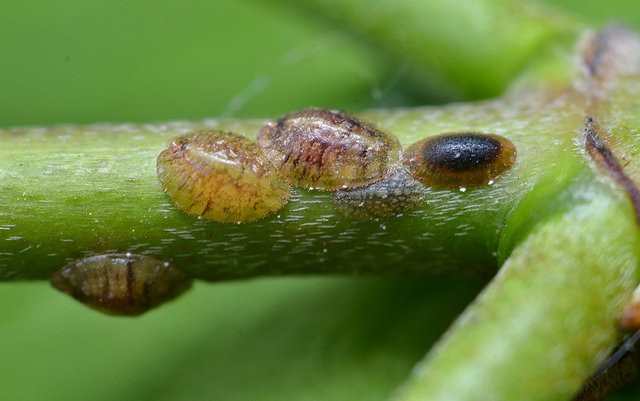Your CannaBiz might not scale up if you are so neglectful as to allow an infestation of Scale to take hold on the marijuana plants under your care. There are two main types of Scale: “Soft” and “Armored” (http://www.ipm.ucanr.edu/PMG/PESTNOTES/pn7408.html).
These tiny insects feed like Aphids, making their living by sucking fluids out of the host plant. There are something like 200 species of these quarter inch critters which to the naked eye resemble a fish scale hugging the plant stem or feeding from a vein on the underside of a leaf. Generally you’ll find the Armored versions on trees and woody shrubs while the Soft variation is most likely to find its way onto vines and field crops. Some of these Soft Scale excrete sugary poop, similar to Aphid Honeydew, and these bugs may also find themselves herded, milked and guarded by Ants. Honeydew accumulations on plant material can lead to troublesome blooms of black sooty mold. Mold spores detected under the microscope is a common cause of rejection of otherwise good looking bud by reputable dispensaries. Prune away heavy infestations and consider sacrificing and replacing any plants that show signs of yellowing or withering. Take care not to inadvertently transfer young scale from infested to unaffected plants.
Should you discover a few isolated Scale during your daily inspections they can be pried off by hand or scraped carefully with a tool. Eggs or live young (crawlers) are often sheltered beneath the mature Scale, so be certain to wipe the area clean. Crawlers can be captured before they settle down to feed by wrapping stems with double sided tape.
More serious infestations can be treated with various clean organic methods. Strive to avoid the use of powerful broad spectrum or systemic insecticides which can kill off beneficial predators while tainting medical marijuana with residual chemicals unfit for human consumption. Destruction of your beneficial ecosystem of insect predators can lead to explosive outbreaks of Spider Mites, perhaps the most destructive and difficult to deal with insect pest of Cannabis. Scale can be kept to a manageable level with ladybugs and parasitic wasps, but if that is impractical you can rely on applications of horticultural oils, insecticidal soaps and herbal repellents. Plants must be generously and thoroughly sprayed, especially the underside of leaves and all through the stem structure for horticultural oil treatment to be effective.
Disclaimer: Any advice and opinions offered about the cultivation of cannabis by Bruce N. Goren are his own and do not represent the University of California or the Master Gardener Program.







SCALE
Armored scales and soft scales are the most common types they are easy to control if you monitor for prevention.
Here are additional controls, some not in your link
Control ants they manage scale pests.
Lacewing Larvae Chrysoperla carnea
Ladybugs Hippodamia convergens are not as good as the ones below.You need to match the control with the pest for best results.
Hyperaspis species are tiny, shiny, black lady beetles with several red, orange, or yellow spots on the back. Rhyzobius lophanthae has a reddish head and underside and a grayish back densely covered with tiny hairs. The twicestabbed lady beetle, Chilocorus orbus, is shiny black with two red spots on its back.
Hyperaspis ladybugs
Rhyzobius
Chilocorus
LINDORUS LOPHANTHAE
Cryptolaemus montrouzieri
Often the most important natural enemies of scales are parasitic wasps, including species of Aphytis,Coccophagus, Encarsia, and Metaphycus. The female wasp lays one or several eggs in or on each scale, where the tiny maggotlike wasp larvae feed. Parasitized scales may become puffy or darken in comparison with unparasitized scales. Sometimes the immature parasites are visible through the scale surface. After completing the larval stage and pupating, the emerging adult of internal parasites typically leaves a round exit hole in the scale it killed. With external parasites that feed outside the scale body, but under the cover of armored scales, their maggotlike larvae may be observed by prying off the scale cover.
Aphytis melinus and other Aphytis species (wasp)
Coccophagus lecanii (wasp)
Encarsia perniciosi (wasp)
Metaphycus helvolus (wasp)